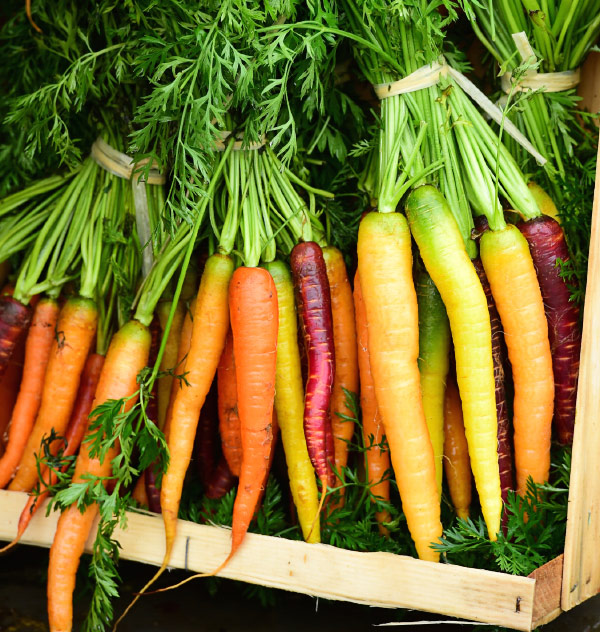Foundations of IPM, Organic Point Way Over Barriers
 |
|
If you could purchase a bunch of “IPM certified” carrots, would you? |
Adherents of organic and IPM practices share a basic principle: emphasis is placed on human health, the environment, and economics. This means that the practices developed and adopted with both approaches must align with the principle. Historically, IPM has focused on pests of any stripe, and was born in response to the overuse of pesticides. Growers have used organic practices for centuries on farms and in fields, big and small, and have developed new ideas along the way. When the USDA established the organic certification program, growers had the option of producing food guided by laws. Meanwhile, growers practicing IPM have operated without a clear definition. Even the highest level of IPM, which has aims similar to organic, receives no price premiums or special marketing.
Organic and IPM production brings a common benefit: reduced consumer exposure to pesticides in the diet. IPM and organic production brings another equally important benefit: biodiversity in the environment. In addition, some organic foods can have higher levels of certain specific nutritional components, higher antioxidant levels, and greater nutrient density than some conventionally produced foods.
Overcoming the Barriers to More IPM and Organic
Organic and IPM adoption—and benefits—remain far short of potential. Less than 1% of US cropland is certified organic (USDA ERS 2013). Only about 10% of cropland benefits from a high level of IPM practices (USDA NRCS CEAP). Agriculture research, development, and outreach benefit everyone. Because IPM and organic practices are knowledge-intensive and focus on ecologically-based problem solving, they could be easily adopted and widely used, even in conventionally-grown crops. The small share of revenue in organic and IPM production is not a fair measure of success. Knowledge cannot be bought or sold, like a jug of chemicals or a bag of compost. Farmers—whether organic, IPM, or conventional—who apply excessive inputs are seldom held accountable. However, corporate sustainability efforts are increasing pressure on all growers to improve.
A New Approach
IPM could help growers solve many problems with numerous pests. In the case of weeds, the knowledge infrastructure needed to practice Integrated Weed Management (IWM) is being compromised by the ease of single applications of herbicides to crops grown in monoculture and genetically engineered to be tolerant of a chemical. It’s no wonder that weeds in over 90% of corn and soybeans in the US are managed without IWM. The IPM model is based on knowledge, understanding, and often requires outside-the-box thinking, all of which take time. The practices that do not use IWM are based primarily on salable products and powerful market mechanisms to push them along.
Public funding to land-grant universities is on the decline, yet institutions still need money to educate students and make new scientific discoveries. However, patents, as revenue streams, do not work, let’s say, on cover-cropping practices that will decrease soil pests. This forces some researchers to choose to identify the active components that suppress pests, which generates funding for their program and graduate students, but prevents them from doing the ecologically-based research on cover crop systems. Actually growing and incorporating a cover crop might improve several aspects of soil health, including organic matter as well as beneficial microbes, but selling a pest-suppressing chemical brings short-term financial gain. And innovative systems thinking is kept on the back burner for another day.
Expanding Adoption
Some growers use the “high-input” strategy to meet expectations for top yields and economic returns without regard to externalized environmental and human health costs. The business model promotes this focus, even for IPM and organic. When implemented by farmers who seek to maximize short-term profits and who are not expected to pay for those external costs, the resulting environmental impacts are often linked to major issues—like hypoxia in the Chesapeake Bay, Great Lakes, and Gulf of Mexico. Or groundwater contamination by nutrients and pesticides. Or unacceptable levels of soil erosion.
Compensating Environmental and Societal Benefits
Farmers are, of course, central to agroecosystems. Whether a grower uses certified organic, conventional, or IPM practices, too often the yield of their crop is their sole measure of success. For sustainable agriculture to thrive, growers must value additional measures of success. Improved soil health, reduced greenhouse gas emissions, reduced energy consumption, decreased pesticide use, community vitality, and other societal and environmental measures—all need to be teamed with economic success. More farmers could be the leaders in sustainability. Innovation, problem-solving, and conservation will happen when the focus is on more than just yield and economics.
This article is based on work of the North Central IPM Center’s Organic and IPM Working Group.
— by CHRIS GONZALES and STEVE YOUNG
The Northeastern IPM Center promotes integrated pest management for reducing risks to human health and the environment. If republishing our news, please acknowledge the source (“From Northeast IPM Insights”) along with a link to our website.
